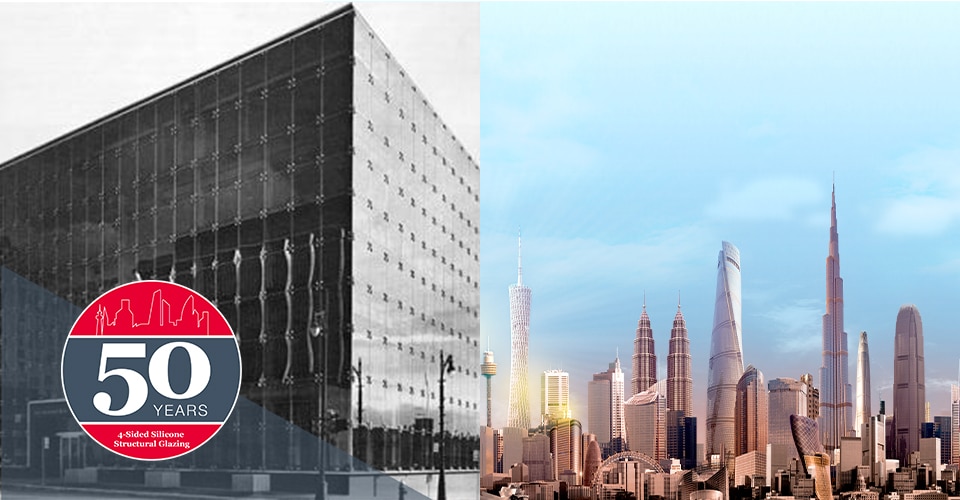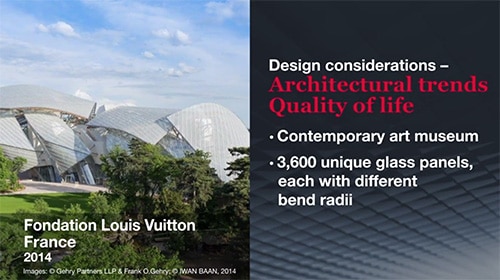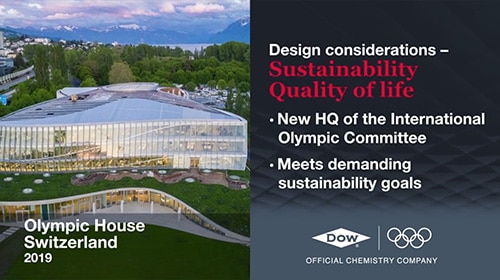Inspiring the “futurescape” with 50 years of Dow technology


Across the globe, people are demanding safer, more sustainable and more aesthetically pleasing structures in which to work, live, shop, travel and play.
Materials science is a key to making this happen. At Dow, we’re developing innovative building materials that help support greater design flexibility and sustainability. These innovations allow architects and builders to bring forth new designs – to redefine the built environment of tomorrow – to “inspire the futurescape.” It’s something we have been doing for more than a half-century. In fact, 2021 marks the 50th anniversary of Dow’s pioneering four-sided silicone structural glazing (SSG), which helped to enable many of the visually stunning glass façades seen in cities across the world today.
More than half the world’s population now lives in urban areas1, a percentage that has risen dramatically over the last half-century2. To accommodate this growing migration into the cities, urban centers have been expanding outward … and upward. At the same time, buildings account for nearly 40% of the world’s energy consumption3. Architects have been challenged to develop new tall structures and retrofit existing structures to be safer, more energy-efficient and light-filled.
Since the early 1950s and 1960s, Dow technologies – including silicone weatherproofing sealants and two-sided silicone structural glazing – have helped architects create energy-efficient, cost-effective, safe, aesthetically pleasing and sustainable buildings. In 1971, our pioneering four-sided silicone structural glazing (SSG) materials helped enable visually stunning glass façades and helped change the face of many urban landscapes. Dow continues to bring innovations to the market such as higher-design-strength silicone, blast-resistant and protective glazing solutions, frameless glazing balustrades and crystal-clear silicone spacers that bring glazing aesthetics to the next level.
DOWSIL™ Silicone Technologies are used for structural glazing, weatherproofing, window and door installation, insulating glass as well as fire protection. The technology is often specified for high-profile buildings with challenging conditions, such as:





These technologies are not only energy-efficient, they are durable – helping to extend the life of these structures.
Most of Dow’s sealants are also certified as low-VOC, which limits unnecessary volatiles from being released in the environment. And the carbon ratio between the emissions to produce silicone and the savings it provides in application is between 1/20 and 1/60.
Our technologies are also being used to upgrade existing buildings. “It’s almost always ‘greener’ to retrofit an old building than to tear it down and construct a new one,” says Jean-Paul Hautekeer, global marketing director, High Performance Building, Dow. “With our customers and partners, we are developing solutions specific to this retrofitting market – such as air barrier systems, sealants for double and triple glazing, high-performance dual-seal windows perimeter systems, and panel-bonding silicone for durable and low-maintenance cladding and rain-screens.”
At their May 18-20, 2021, Awards Conference, the Council on Tall Buildings and Urban Habitat (CTBUH) reco gnized six Dow-connected projects as winners in the Best Tall Building category. The CTBUH Awards program4 honors projects that have made extraordinary contributions to the advancement of tall buildings and the urban environment, and that achieve sustainability at the highest and broadest level.
Learn more about Dow’s sustainable technologies for the building and construction market.
Contact us to discuss how Dow technologies can help you “inspire the futurescape” by creating energy-efficient, high-performance and sustainable structures.
155% of people (4.1 billion) live in urban areas. https://ourworldindata.org/urbanization
2In 1960, twice as many people lived in rural settings (2 billion) than in urban areas (1 billion). https://ourworldindata.org/urbanization
32019 Global Status Report for Buildings and Construction. Global Alliance for Buildings and Construction. https://www.google.com/url?sa=t&rct=j&q=&esrc=s&source=web&cd=&ved=2ahUKEwi6nO_O7eTwAhWOyp4KHc8-BI4QFjAQegQIEhAD&url=https%3A%2F%2Fwedocs.unep.org%2Fbitstream%2Fhandle%2F20.500.11822%2F30950%2F2019GSR.pdf&usg=AOvVaw1-Dx9mqi04uu7QPWiNkWKu
4More information on the awards can be found at https://awards.ctbuh.org.